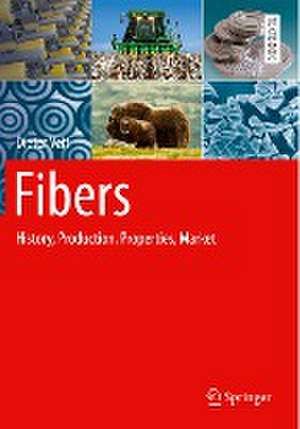Fibers: History, Production, Properties, Market
Autor Dieter Veiten Limba Engleză Paperback – 11 ian 2024
| Toate formatele și edițiile | Preț | Express |
|---|---|---|
| Paperback (1) | 643.40 lei 3-5 săpt. | +73.84 lei 4-10 zile |
| Springer International Publishing – 11 ian 2024 | 643.40 lei 3-5 săpt. | +73.84 lei 4-10 zile |
| Hardback (1) | 1073.64 lei 3-5 săpt. | |
| Springer International Publishing – 10 ian 2023 | 1073.64 lei 3-5 săpt. |
Preț: 643.40 lei
Preț vechi: 804.25 lei
-20% Nou
Puncte Express: 965
Preț estimativ în valută:
123.12€ • 128.87$ • 102.47£
123.12€ • 128.87$ • 102.47£
Carte disponibilă
Livrare economică 10-24 martie
Livrare express 21-27 februarie pentru 83.83 lei
Preluare comenzi: 021 569.72.76
Specificații
ISBN-13: 9783031153112
ISBN-10: 3031153111
Pagini: 1040
Ilustrații: XXII, 1040 p. 1265 illus., 698 illus. in color.
Dimensiuni: 178 x 254 x 58 mm
Greutate: 1.98 kg
Ediția:1st ed. 2022
Editura: Springer International Publishing
Colecția Springer
Locul publicării:Cham, Switzerland
ISBN-10: 3031153111
Pagini: 1040
Ilustrații: XXII, 1040 p. 1265 illus., 698 illus. in color.
Dimensiuni: 178 x 254 x 58 mm
Greutate: 1.98 kg
Ediția:1st ed. 2022
Editura: Springer International Publishing
Colecția Springer
Locul publicării:Cham, Switzerland
Cuprins
Part 1. Fundamentals.- Chapter 1. Definitions.- Chapter 2. History.- Chapter 3. Market.- Chapter 4. Inner Structure of Fibers.- Part 2. Natural Fibers.- Chapter 5. Cotton.- Chapter 6. Bast Fibers.- Chapter 7. Hard Fibers.- Chapter 8. Fruit Fibers.- Chapter 9. Wool.- Chapter 10. Fine Animal Hair.- Chapter 11. Silk.- Chapter 12. Asbestos.- Chapter 13. Other Natural Fibers.- Part 3. Chemical Fibers – Processes and Machines.- Chapter 14. Synthetic Man-made Fibers – Polymer Formation Processes.- Chapter 15. Aggregates for Polymer Formation.- Chapter 16. Processes for the Production of Man-made Fibers.- Chapter 17. Aggregates for the Production of Synthetic Filaments.- Chapter 18. Aggregates for the Production of Solution Spun Man-made Fibers.- Chapter 19. Processes for the Production of Textile Filament Yarns.- Chapter 20. Processes for the Production of Industrial Yarns.- Chapter 21. Process for the Production of Monofilaments.- Chapter 22. Process for the Production of Carpet Yarns.- Chapter 23. Process for the Production of Film Yarns.- Chapter 24. Processes for the Production of Staple Fibers.- Chapter 25. Processes for the Production of Nonwovens.- Chapter 26. Bicomponent Fibers.- Chapter 27. Fine Fibers.- Chapter 28. Aerogels.- Chapter 29. Texturing.- Part 4. Synthetic Chemical Fibers – Production and Properties.- Chapter 30. Polyester.- Chapter 31. Polyamide.- Chapter 32. Aramid.- Chapter 33. Polyolefins.- Chapter 34. Polyacrylonitrile.- Chapter 35. Polylactic Acid.- Chapter 36. Elastane.- Chapter 37. High Performance Fibers.- Chapter 38. Carbon Fibers.- Chapter 39. Carbon Nanotubes and Graphene.- Chapter 40. Optical Fibers.- Part 5. Cellulosic Chemical Fibers – Production and Properties.- Chapter 41. Cellulosic Man-made Fibers.- Part 6. Biopolymers.- Chapter 42. Biopolymers.- Part 7. Inorganic Fibers.- Chapter 43. Glass Fibers.- Chapter 44. Basalt Fibers.- Chapter 45. Ceramic Fibers.- Part 8. Metal Fibers.- Chapter 46. Metal Fibers.- Part 9. Test Methods.- Chapter 47. Test Methods.- Part 10. Properties of Natural and Chemical Fibers.- Chapter 48. Properties.- Part 11. Producers and Trade Names.- Chapter 49. Producers and Trade Names.- Part 12. Outlook and Trends.- Chapter 50. Outlook and Trends.
Notă biografică
Dieter Veit has studied mechanical engineering with a major in textiles at RWTH Aachen University. After completing his Dr.-Ing., he worked in man-made fiber plant engineering and since 2001 he has been giving lectures on natural and man-made fibers at RWTH Aachen University. He authored and edited several books on textile technology and artificial intelligence.
Textul de pe ultima copertă
This textbook covers the production of all relevant natural and man-made fibers, their inner structure, properties, applications, markets and historic development. More than 1,600 photos, maps and sketches complement the text. The properties of important fibers are compared in a large number of tables and graphics to simplify selecting an appropriate fiber for a given application.
The Content:
Dieter Veit has studied mechanical engineering with a major in textiles at RWTH Aachen University. After completing his Dr.-Ing., he worked in man-made fiber plant engineering and since 2001 he has been giving lectures on natural and man-made fibers at RWTH Aachen University. He authored and edited several books on textile technology and artificial intelligence.
This book is a translation of an original German edition. The translation was done with the help of artificial intelligence (machine translation by the service DeepL.com). A subsequent human revision was done primarily in terms of content, so that the book will read stylistically differently from a conventional translation.
The Content:
- Natural fibers: History, production, properties, applications, markets.
- Chemical fibers: History, production processes, components and machines for the manufacturing of cellulosic and synthetic fibers, properties, applications, markets.
- Special topics: Metal fibers, carbon nanotubes, biopolymers, optical fibers, high-performance fibers, fiber testing etc.
- Students in textile and clothing technology in all course programs
- Experts in the textile and clothing industry and fiber and textile research.
Dieter Veit has studied mechanical engineering with a major in textiles at RWTH Aachen University. After completing his Dr.-Ing., he worked in man-made fiber plant engineering and since 2001 he has been giving lectures on natural and man-made fibers at RWTH Aachen University. He authored and edited several books on textile technology and artificial intelligence.
This book is a translation of an original German edition. The translation was done with the help of artificial intelligence (machine translation by the service DeepL.com). A subsequent human revision was done primarily in terms of content, so that the book will read stylistically differently from a conventional translation.
Caracteristici
Describes the state-of-the art of fiber production comprehensively Simplifies product developers the choice of the right material depending on the application. Gives a quick overview of all relevant fibers through numerous maps, photos, drawings and tables.
